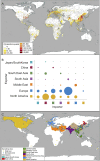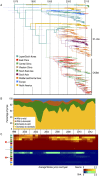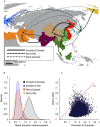Ecosystem Interactions Underlie the Spread of Avian Influenza A Viruses with Pandemic Potential
- PMID: 27166585
- PMCID: PMC4864295
- DOI: 10.1371/journal.ppat.1005620
Ecosystem Interactions Underlie the Spread of Avian Influenza A Viruses with Pandemic Potential
Abstract
Despite evidence for avian influenza A virus (AIV) transmission between wild and domestic ecosystems, the roles of bird migration and poultry trade in the spread of viruses remain enigmatic. In this study, we integrate ecosystem interactions into a phylogeographic model to assess the contribution of wild and domestic hosts to AIV distribution and persistence. Analysis of globally sampled AIV datasets shows frequent two-way transmission between wild and domestic ecosystems. In general, viral flow from domestic to wild bird populations was restricted to within a geographic region. In contrast, spillover from wild to domestic populations occurred both within and between regions. Wild birds mediated long-distance dispersal at intercontinental scales whereas viral spread among poultry populations was a major driver of regional spread. Viral spread between poultry flocks frequently originated from persistent lineages circulating in regions of intensive poultry production. Our analysis of long-term surveillance data demonstrates that meaningful insights can be inferred from integrating ecosystem into phylogeographic reconstructions that may be consequential for pandemic preparedness and livestock protection.
Conflict of interest statement
The authors have declared that no competing interests exist.
Figures



Similar articles
-
Are Poultry or Wild Birds the Main Reservoirs for Avian Influenza in Bangladesh?Ecohealth. 2017 Sep;14(3):490-500. doi: 10.1007/s10393-017-1257-6. Epub 2017 Jun 15. Ecohealth. 2017. PMID: 28620679 Free PMC article.
-
Avian Influenza Viruses in Wild Birds: Virus Evolution in a Multihost Ecosystem.J Virol. 2018 Jul 17;92(15):e00433-18. doi: 10.1128/JVI.00433-18. Print 2018 Aug 1. J Virol. 2018. PMID: 29769347 Free PMC article.
-
Genetic Evidence Supports Sporadic and Independent Introductions of Subtype H5 Low-Pathogenic Avian Influenza A Viruses from Wild Birds to Domestic Poultry in North America.J Virol. 2018 Sep 12;92(19):e00913-18. doi: 10.1128/JVI.00913-18. Print 2018 Oct 1. J Virol. 2018. PMID: 30045988 Free PMC article.
-
Phylodynamic approaches to studying avian influenza virus.Avian Pathol. 2023 Oct;52(5):289-308. doi: 10.1080/03079457.2023.2236568. Epub 2023 Aug 11. Avian Pathol. 2023. PMID: 37565466 Review.
-
Prevalence of avian influenza viruses and their associated antibodies in wild birds in China: A systematic review and meta-analysis.Microb Pathog. 2019 Oct;135:103613. doi: 10.1016/j.micpath.2019.103613. Epub 2019 Jun 26. Microb Pathog. 2019. PMID: 31254602
Cited by
-
H9N2 Influenza A Virus Isolated from a Greater White-Fronted Wild Goose (Anser albifrons) in Alaska Has a Mutation in the PB2 Gene, Which Is Associated with Pathogenicity in Human Pandemic 2009 H1N1.Genome Announc. 2016 Sep 1;4(5):e00869-16. doi: 10.1128/genomeA.00869-16. Genome Announc. 2016. PMID: 27587808 Free PMC article.
-
Occupational Risk from Avian Influenza Viruses at Different Ecological Interfaces Between 1997 and 2019.Microorganisms. 2025 Jun 14;13(6):1391. doi: 10.3390/microorganisms13061391. Microorganisms. 2025. PMID: 40572281 Free PMC article. Review.
-
Maintenance and dissemination of avian-origin influenza A virus within the northern Atlantic Flyway of North America.PLoS Pathog. 2022 Jun 6;18(6):e1010605. doi: 10.1371/journal.ppat.1010605. eCollection 2022 Jun. PLoS Pathog. 2022. PMID: 35666770 Free PMC article.
-
A Review of Avian Influenza A Virus Associations in Synanthropic Birds.Viruses. 2020 Oct 23;12(11):1209. doi: 10.3390/v12111209. Viruses. 2020. PMID: 33114239 Free PMC article. Review.
-
Transmission Dynamics of Highly Pathogenic Avian Influenza Virus A(H5Nx) Clade 2.3.4.4, North America, 2014-2015.Emerg Infect Dis. 2018 Oct;24(10):1840-1848. doi: 10.3201/eid2410.171891. Emerg Infect Dis. 2018. PMID: 30226167 Free PMC article.
References
Publication types
MeSH terms
Associated data
Grants and funding
LinkOut - more resources
Full Text Sources
Other Literature Sources
Medical

